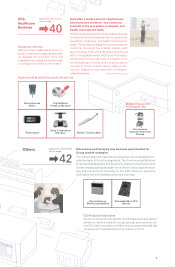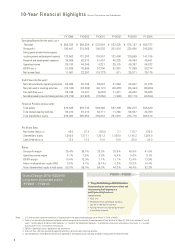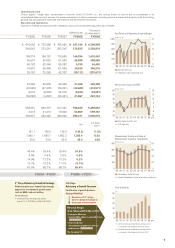Omron 2009 Annual Report Download - page 19
Download and view the complete annual report
Please find page 19 of the 2009 Omron annual report below. You can navigate through the pages in the report by either clicking on the pages listed below, or by using the keyword search tool below to find specific information within the annual report.
17
How will AEC be transformed in light of the huge impact the global recession has
had on the automotive industry?
Q
AEC to be Spun Off to Leverage Autonomous
Management and Collaborative R&D, and
Operations Catered to the Automotive Industry
Worldwide automobile production has been rapidly
declining since reaching a peak in 2007. The industry
has been simultaneously undergoing a major transi-
tion, bringing rapid growth in demand for compact cars
and eco cars along with an increasing need for elec-
tronic components. From a long-term perspective, this
shift presents a business opportunity for AEC. However,
since increasing sales is meaningless if the business
still produces a loss, going forward AEC must stress
the distinct strengths of its automotive products.
We are therefore reorganizing AEC by shifting the
mechanical components operation to ECB and focus-
ing AEC resources on developing its distinct strengths
in electronic control units (ECUs) and other automo-
tive electronics. AEC will continue developing ECUs
on Omron’s sensing and control technology with a
focus on electronic equipment for auto bodies that will
contribute to the realization of comfortable and easy-
to-use automobiles. The primary focus will be power
window switches and keyless entry systems along
with next-generation automotive systems, such as
passive entry and engine push-start systems (please
see page 37 for details). Our strategy is to raise profitability
by focusing on specific technologies with worldwide
applications.
In addition, automotive electronics are being used
in a wider range of applications as the industry rapidly
advances development of hybrid vehicles, electric cars,
and other environmentally friendly automobiles. As the
applications become more diverse, the technology is
becoming increasingly sophisticated and complex, rais-
ing the importance of vigorous and flexible collaborative
R&D and operations with other companies.
The changes in the automobile industry have made
it vital that we modify our previous approach of some
Omron Group companies supplying automotive parts
to all clients on an equal basis. To this end, we plan to
promote the transformation of AEC into a highly spe-
cialized company that specializes in electronic
equipment for auto bodies by spinning it off in April 2010
to leverage the benefits of autonomous management,
the ability to concentrate on core clients, and greater
latitude for collaborations with other companies for prod-
uct concept generation and business realization.
What operational reforms will be implemented as part of
Omron’s structural reform?
Q
Four Areas of Management Reform
Management reform will be carried out in four cate-
gories. First, we will consolidate our 49 domestic and
overseas production sites and reduce the number of
sites by one-third. Six production sites are now being
shut down, including the Minakuchi Factory (semicon-
ductor manufacturing operations were shifted to the
larger Yasu Factory) and the automotive electronic com-
ponents manufacturing facility in England (we are
continuing to meet demand in Europe through exports
from other factories). We will keep implementing man-
agement reforms as necessary.
The second operational reform will be to revise the
variable costs structure. We will continue to develop
common product formats and to progress with stan-
dardization. At the same time, we will reduce the
number of parts that must be purchased, conduct bulk
purchases to lower materials costs, and decrease the
number of man-hours necessary for inspection of com-
ponents, quality assurance, and final product
inspection. Through these measures, we are aiming
to lower the variable cost ratio by 2.5 percentage points
by fiscal 2011 in comparison to fiscal 2008.
Third is reform of our IT structure. We began
reforming the Group’s IT structure in fiscal 2007 with
the aims of improving our administrative efficiency
and establishing an infrastructure for information shar-
ing throughout our worldwide manufacturing, sales,
development, and finance operations. We have bud-
geted ¥10 billion for investment over a four-year period
and expect to have a new IT infrastructure in full oper-
ation in fiscal 2010.
The fourth operational reform concerns the func-
tions of the head offices. We will take a scalpel to the
swelling administrative expenses incurred at the head
offices as our global operations expanded. The head
office staff activities will be divided into support and
strategic functions and strictly evaluated for necessi-
ty and value to trim any and all excess.
Close/consolidate approx. 30% of production sites from FY08 to FY10.
49
Jan. 2009 Mar. 2011
30
̶
35
Number of
Production
Sites*
* Production sites: Sites with production function and/or production management function
Sites to be closed/consolidated (decided in FY08):
Large-sized backlight business: TFO (3 sites)
• Automotive electronic components business:
OUK
(Omron Automotive Electronics UK Ltd.)
• Semiconductor business: Minakuchi factory, Japan
• FA business: OMA
(Omron Manufacturing of America, Inc., US)
Closure/Consolidation of Sites
























